 Add Dowel Path ( Modeling )
Add Dowel Path ( Modeling )
Tool summary :
- Typically used to dowel two concrete members together. The dowel path becomes a component of the member to which it is added .
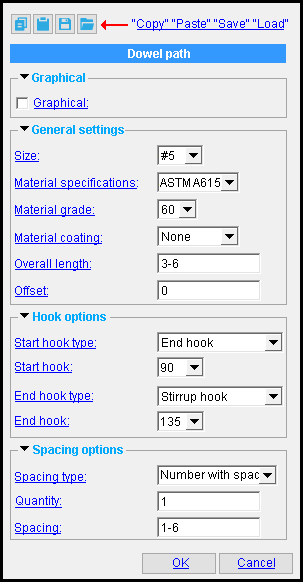
On the [Member Edit] window, the name of the leaf for the dowel path " Component " will be "
Dowel path. "
After you have added a dowel path, you can open this edit window (shown at left) by double-clicking one of the Dowel Path materials while the " Selection filter " is set to ' Default ' or ' All ' or ' Custom Components ''.
Also see :
- Modeling (where custom components can be added)
- Custom components (topic)
- Dowel path ( Home > Project Settings > Job > Plugin Defaults > Component Plugin Defaults > )
- Copy Component (to copy a dowel path custom component to another member)
- Move Component (to move a dowel path custom component to another member)
- Explode Component (to reduce the custom component to its constituent materials)
- Component Selection Tool (to search for custom components of a selected type)
- Model Tree (to find custom components and select them for deletion, editing, etc.)
concrete | model > component > | add component | top
 To add the Dowel Path custom component :
To add the Dowel Path custom component :
Setup of default settings is available for the edit window that opens when you add this component. See Home > Project Settings > Job > [ Component Plugins ] > Components > Component Plugin Setup .
To add the custom component: 1 ) In Modeling , select a member. 2 ) Choose Model > Component > Add . 3 ) On the custom component selection list, choose " Dowel " as the custom component you want to add. 4 ) Pick start and end points for the dowel path. 5 ) The Dowel path window opens. Enter the settings that you want, then press " OK " to close the window. 6 ) If User and Site Options > Modeling > " Automatically process after modeling operation " is set to ' Process and create solids ', the bars will be generated immediately. If not, the bars will be generated in the member the next time the member undergoes Process and Create Solids .
concrete | model > component > | add component | top
 Example: adding a dowel path to join two adjacent concrete slabs
Example: adding a dowel path to join two adjacent concrete slabs
1 . In Modeling , use Snap to Surface or a related tool to go to a plane that is parallel with the top surface of the slab that you will add the dowels to.
2 . Place construction lines so that there in an INCL point at the start and the end of the dowel path. This will include construction lines that are parallel to the dowels and perpendicular to the dowel path that you will place.
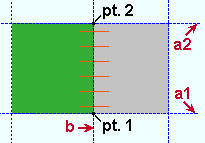
Construction lines a1 and a2 define the start and end the dowel path.
Construction line b follows the direction of the dowel path along the left ends of the dowels.
INCL points 1 and 2 start and end the dowel path.
3 : Choose View > Relative Depth and enter a negative number to go into the view depth. This is the depth at which the center of the dowel will be placed.
Tip: The remainder of your Relative Depth entry when half the diameter of the dowel is subtracted will be top cover for the dowels. (The diameter of the dowel will be determined by the " Size " that you choose when you place the dowel path.)
4 . Select the left slab. This is the slab that you will add the dowels to. The material changes to the " Primary selection color " (green in this example).
5 . Choose Model > Component > Add .
6 . On the custom component selection list, choose " Dowel " as the custom component you want to add, then press " OK ".
7 . Pick the bottom INCL point to define the start and then the top INCL point to define the end of the dowel path.
Note: This example models a single segment dowel path, but you can choose more than two points to make multi-segment paths.
8 . The Dowel path window opens. Enter the settings that you want, such as the " Size ," the " Overall length ," and the " Spacing ," then press " OK " to close the window.
9 . If User and Site Options > Modeling > " Automatically process after modeling operation " is set to ' Process and create solids ', the bars will be generated immediately. If not, the bars will be generated in the member the next time the member undergoes Process and Create Solids .
concrete | model > component > | add component | top
 To delete or edit the Dowel Path custom component :
To delete or edit the Dowel Path custom component :
To delete a Dowel Path custom component: 1 ) Use the Component Selection Tool and select the component in the member. Or , select the component in the Model Tree . 2 ) Press the Delete key (or choose Edit > Delete ). 3 ) Process and Create Solids is required when User and Site Options > Modeling > " Automatically process after modeling operation " is not set to a choice that makes create solids take place automatically.
In the Model Tree , the Dowel Path custom component is listed as Dowel path when " View By " is set to ' Member piecemark ' or ' Member number '. The Dowel Path component is listed under its member, after that member's connection components ( Left End and Right End ), and before that member's submaterials.
To edit a Dowel Path custom component or review its settings, you can find the member it is added to and open its edit window. The component's settings will be contained in that window in a section named [ Dowel path ] . To edit a Dowel path custom component without opening a member edit window, use the Model Tree . You also can use the Selection Filter toolbar item to select the ' Custom Components ' filter and double-click any dowel in the dowel path to edit the component. The Component Selection Tool can also be used to edit (and find) custom components.
page 1 | contents | model > component
 Dowel Path custom component settings :
Dowel Path custom component settings :
| Dowel path |
 ------ Graphical -------
------ Graphical -------
|
A Dowel Path component is automatically set to "
Graphical " whenever you make graphical changes to any of its dowels. For example, when you Edit Material or apply the Extend Rebar Ends tool on a dowel. This stops the component from being changed during Process and Create Solids . Click here for more information.
Instead of allowing the component to be made "
Graphical ," you may wish to Explode Component .
 ------ General settings -------
------ General settings -------
Size: A size designation that has been entered to the Rebar Definitions Setup window under the " Active rebar standard ".
Material specifications: A615 or A706 or etc. This is an ASTM specification entered into the Rebar Specifications window.
Material grade: 60 or 40 or etc. This is the yield strength (grade) of the rebar.
The grade choices in this list box are limited to those entered in the Rebar Specification window for the " Specification " chosen for this rebar.
Material coating: None or a Coating designation that is available in the " Standard " that you have selected.
The coating choices in this list box are limited to those entered in the Rebar Specification window for the " Specification " chosen for this rebar shape.
Select ' None ' if you do not want a coating. Since it is possible to create specifications that do not have coatings, it is possible that ' None ' may be your only option.
User configuration: If a coating is not available for selection, selecting a different " Specification " will make that coating available if the coating you want is in that other standard. If you don't want to change to a different " Specification ," you can open the Rebar Specifications window and add the coating you want to the specification that you currently have selected.
Overall length: A distance (in the primary dimension " Units " or other units ). This is the length of the each rebar.
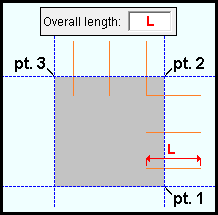
|
When points are placed counterclockwise -- that is, placed in the order they are numbered here -- the " Overall length " is placed on the outside of the dowel path, less the " Offset ." |
Offset: A distance (in the primary dimension " Units " or other units ). The rebar is offset from the dowel path that you enter by this distance. If you place the path's points along the edge of a member, this is the length by which each rebar is doweled into (or protrudes out of) the member. The direction of the offset is determined by the order in which you placed the points.
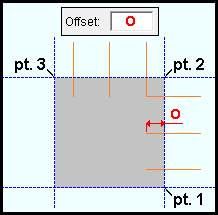
When points are placed counterclockwise -- that is, placed in the order they are numbered here -- the " Offset " is placed on the inside of the dowel path. Tip: If you want the dowels embedded equally in two adjacent members, and the dowel path is along the edge of one member, enter an " Offset " that is one half the " Overall length " of each dowel.
 ------ Hook options ------
------ Hook options ------
Start hook type: None or End hook or Stirrup Hook or Seismic Hook . This is the type of hook, if any, that appears at the left end of the rebar shape material. The " Hook type " chosen here determines which choices are available for the " Start hook bend " setting.
|
Hook
type |
Available angles |
| None | -- |
| End hook | 90, 180, -90, -180 |
| Stirrup hook | 90, 135, -90, -135 |
|
Seismic
stirrup hook |
135, -135 |
Start hook bend: None or 180 or 135 or 90 or -90 or -135 or -180 . This is the bend, if any, that appears at the left end of the rebar shape material. The entries available here are determined by the entry made to " Start hook type ". The only entry available for seismic stirrups is (±) 135 .
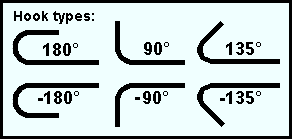
End hook type: None or End hook or Stirrup Hook or Seismic Hook . This is the type of hook, if any, that appears at the right end of the rebar shape material. The " Hook type " chosen here determines which choices are available for the " End hook bend " setting.
|
Hook
type |
Available angles |
| None | -- |
| End hook | 90, 180, -90, -180 |
| Stirrup hook | 90, 135, -90, -135 |
|
Seismic
stirrup hook |
135, -135 |
End hook bend: None or 180 or 135 or 90 or -90 or -135 or -180 . This is the bend, if any, that appears at the right end of the rebar shape material. The entries available here are determined by the entry chosen for " End hook type ". The only entry available for seismic stirrups is (±) 135 .

 ------ Spacing options -------
------ Spacing options -------
Spacing type: Max spacing or Number or Number with spacing .
' Max spacing ' will space the rebar by a distance that is no greater than the " Spacing " you enter for the dowel path segments.
' Number ' (of spaces) will space the rebar evenly between the points that you entered for each segment of your rebar path. The number of spaces include the space at the start and end of the dowel path in addtion to the spaces between the bars.
' Number with spacing ' will use " Quantity " of rebar spaces and the " Spacing " that you enter. These entries will be applied to each segment of the dowel path. Note that the rebar will be placed beyond the dowel path segment you entered if the spacing distance multiplied by the quantity is greater than the length of the segment.
Quantity: The number of spaces on each straight segment of the rebar path. This applies when " Spacing type " is ' Number ' or ' Number with spacing ' . This option does not specify the quantity of rebar .
Spacing: A distance (in the primary dimension" Units " or other units ). This applies when " Spacing type " is ' Max Spacing ' or ' Number with spacing ' .
When the " Spacing type " is ' Max spacing ' , the spacing distance is applied between the reinforcing bars and equally divided between the space before the first and after the last reinforcing bar. This distance will be no greater than the " Spacing " distance that you enter.
When the " Spacing type " is ' Number ', the entry to " Spacing " is applied between the reinforcing bars and the space before the first rebar.







